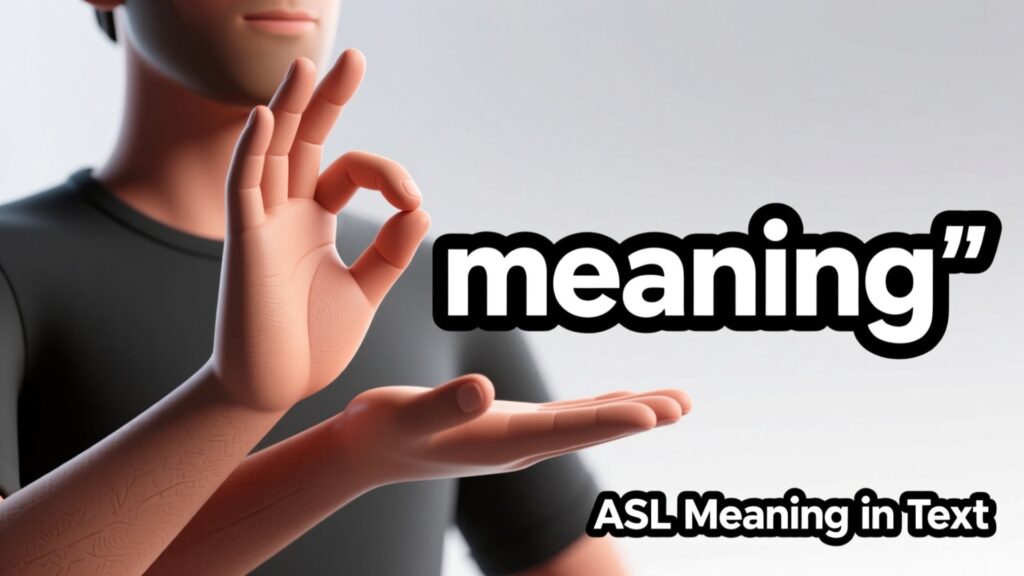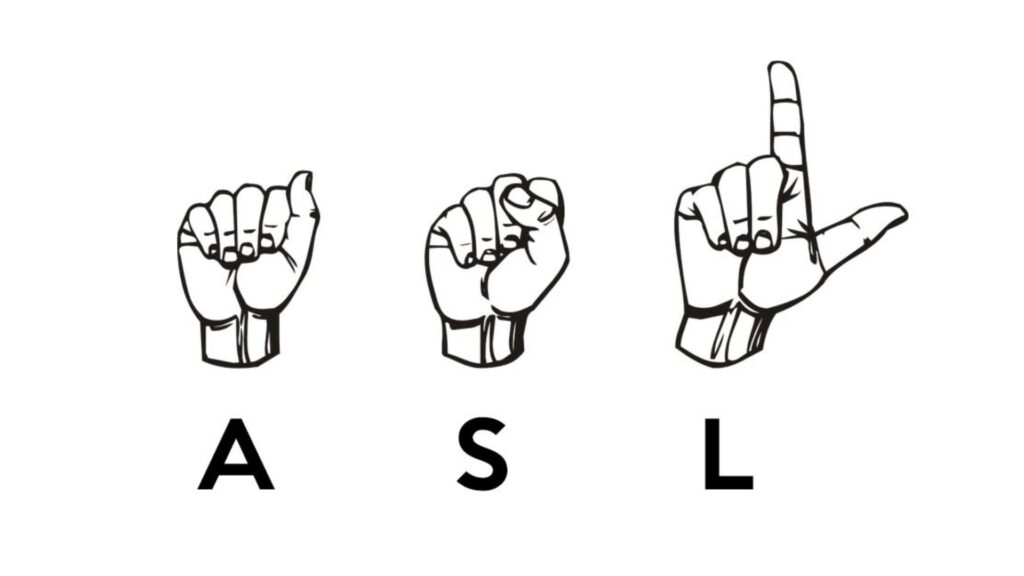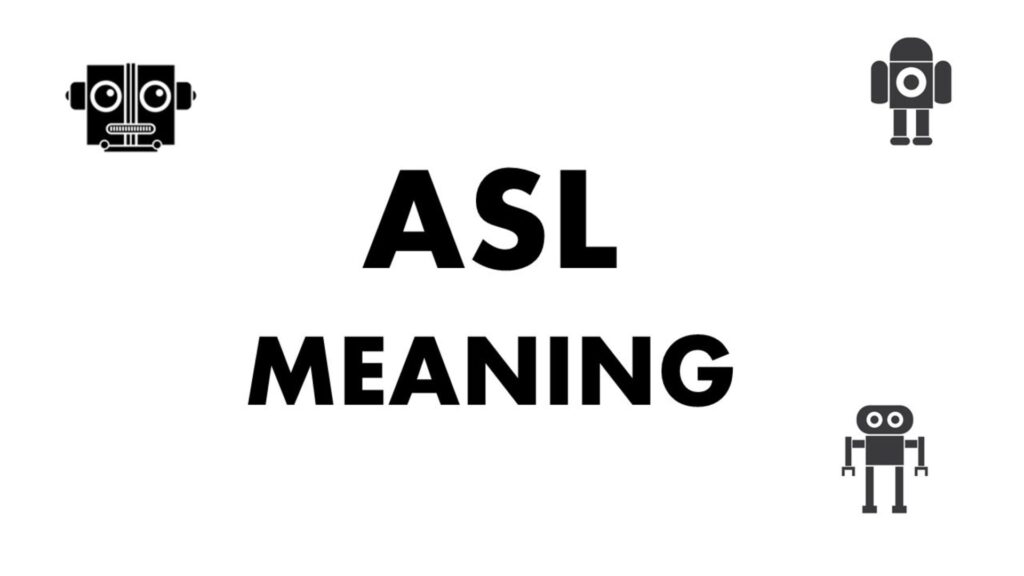Keyword focus: what does asl stand for in text, what does asl mean in text, asl meaning in text, asl meaning texting, what does asl stand for text
Introduction: The Three-Letter Acronym That Could Change the Tone of Your Message

Have you ever scrolled through a chat or a post and seen “ASL?” popped up and thought: What does ASL stand for in text? Or maybe you saw someone type “That’s cool ASL” and wondered: What does ASL mean in text now?
In this post I’ll guide you through the full story: what “ASL” means, how it grows with social media, and how to use (or avoid) it smartly in 2025. Because meaning shifts fast, and context matters a lot.
What Does ASL Mean in Text?
When exploring what does asl mean in text you’ll find primarily two real usages today:
- “Age, Sex, Location” the classic chat-room question in early online messaging.
- “As hell” a newer slang intensifier used among younger users and on social platforms.
Here’s a quick comparison:
| Meaning | Expansion | Example Sentence | Where You See It |
|---|---|---|---|
| Age/Sex/Location | A/S/L asking for personal details | “ASL?” → “18 F NY” | Chatrooms, early forums |
| As hell (intensifier) | “as hell” (i.e. very/extremely) | “I’m tired ASL” → “I’m super tired” | TikTok, Snapchat, Twitter |
So when someone types what does asl stand for text?, you need to ask: “Which meaning do they mean?” The audience and platform give you clues.
How ASL Evolved: From Chatrooms to TikTok Slang
Understanding asl meaning in texting means tracing how it shifted across internet eras:
- In the 1990s and early 2000s, “ASL?” meant “age/sex/location”. Users in chatrooms like AOL, ICQ, IRC, Yahoo used it to break the ice.
- Over time, as smartphone texting and social media exploded, slang evolved. One new usage for “ASL” turned into the intensifier “as hell” among Gen Z and younger online.
- The shift reflects how online language often adapts and overlaps: old meanings stick while new ones arise.
- As of 2025, many people still know the original “age/sex/location” meaning; but many younger users interpret ASL as “as hell” which can lead to confusion.
So when you ask what does asl meaning in text? You’re asking about a layered acronym with more than one life.
Understanding the Tone and Context Behind “ASL”
The meaning of “ASL” isn’t fixed. How you read it depends on tone, punctuation, platform and audience. Here’s how to decode what does asl mean in text in practice.
Tone & Clues to Watch
- Question mark: “ASL?” often signals age/sex/location.
- Standalone: If someone just types “ASL” or “asl” at the end of a sentence, they might mean “as hell.”
- Audience & platform: On LinkedIn or email, “ASL?” probably isn’t polite unless you know the joke. In group chats or TikTok comments, “ASL” might be used to intensify (“funny ASL”).
- Capitalization & context: “That party was wild ASL” clearly uses the intensifier meaning. “Hey ASL?” from a stranger might ask for personal info.
Examples
- “ASL?” → “Hi, what’s your age, sex, and location?” (age/sex/location meaning)
- “I’m hungry ASL” → “I’m very hungry.” (as hell meaning)
- “Your profile pic is nice ASL?” → potentially intrusive.
- “Work’s been boring ASL” → casual, friendly exaggeration.
Key takeaway: Always ask yourself: What’s the relationship? What’s the platform? What’s being asked? That will tell you which meaning is active.
What ASL Does Not Mean (and Why It Matters)
When diving into asl meaning texting, knowing what “ASL” does not mean avoids embarrassing or risky misreads.
- “ASL” does not mean American Sign Language in this context. Though ASL often refers to that language, in chats it usually means something else.
- It doesn’t always mean “as hell” assuming that automatically might misinterpret someone’s intention.
- Failing to recognise the age/sex/location meaning might expose privacy risks, especially for younger users: someone asking “ASL?” might be fishing for personal details.
Why it matters: Miscommunication can cause awkwardness, offend someone, or open the door to privacy concerns. Understanding the correct meaning helps you respond appropriately, safely and confidently.
When and How to Use “ASL” Correctly
Wondering how to use asl meaning in text? Here’s a guide to when it fits and when it doesn’t.
Use “ASL” (age/sex/location) – Only in very informal, private settings with trusted people
- Use when chatting with someone you know and it fits context.
- Example: “ASL? 24/M/NYC.”
- Avoid using in public posts, on professional networks, or with strangers.
Use “ASL” (as hell) – When you want to emphasize in casual conversation
- Example: “That movie was scary ASL.”
- Works best among friends, informal group chats, social media where casual tone is expected.
- Avoid using it in formal or professional communication it may come off as unprofessional or unclear.
Platform and audience considerations
| Context | Use ASL? | Why |
|---|---|---|
| Texting a close friend | ✅ Yes | Casual and fun |
| Direct message with stranger | ❌ No | Risky (privacy) |
| Professional email | ❌ No | Too informal, ambiguous |
| Public social post to broad audience | ⚠️ Maybe | Understand your audience and the meaning |
| Chat in gaming/social apps | ✅ Often yes | Expect slang, quick language |
Best practices
- If you ask “what does asl mean in text?” more than twice in one conversation, maybe clarify: “By ASL you mean age/sex/location or as hell?”
- When you’re asked “ASL?” and you’re unsure, you can politely respond with “Could you clarify what you mean by ASL?”
- If using “ASL” as “as hell,” still ensure the context makes sense: you don’t want someone reading it as a personal question.
Alternatives to Using “ASL” in Different Tones

If you prefer to avoid ambiguity or want to match your tone better, here are polite, casual, and professional alternatives to using “ASL.”
When you’re writing in 2025 you might favour clarity over shorthand.
✅ Polite Alternatives
- “How are you doing?”
- “Where are you based?”
- “Tell me a little about yourself.”
✅ Casual Alternatives
- “You from around here?”
- “What city you in?”
- “That was crazy, right?”
✅ Professional Alternatives
- “Could you share your current location?”
- “What age range are you in (optional)?”
- “Which department or city are you working from?”
Using these alternatives helps avoid confusion especially important when audience spans generations or platforms.
How to Respond to “ASL?” Gracefully and Safely
When someone uses “ASL?” and you’re asked either meaning, your response strategy can vary by tone and your comfort level.
💬 Polite Responses (for age/sex/location meaning)
- “Hi 25 /M/Chicago. How about you?”
- “I’d prefer not to share that but happy to chat about [topic].”
💬 Casual Responses (for “as hell” meaning)
- “Yeah, I’m tired ASL today 😅”
- “That concert was fun ASL!”
💬 Professional or Reserved Responses
- “I prefer not to disclose personal info thanks for understanding.”
- “I believe we should keep location private in this forum.”
Safety tips
- If you suspect someone is using “ASL?” to get personal information from you and you’re uncomfortable:
- Don’t respond or share sensitive data.
- Redirect: “What brings you to this group? Let’s talk about [topic].”
- Remember: younger users especially should avoid sharing personal details online.
When Not to Use “ASL?”
Knowing when not to respond is just as important as knowing how to respond. Some scenarios demand caution.
- If a stranger’s first message is “ASL?” and nothing else that’s a red flag.
- In professional settings assuming “ASL” is appropriate can harm your credibility.
- On public social posts using “ASL” as slang may confuse older or wider audiences.
- If you’re unsure which meaning is intended better to clarify than assume.
Being mindful helps you maintain clear, safe, and effective communication.
Contextual Comparison: ASL vs. Other Acronyms
Understanding what does asl mean in text gets clearer when you compare it to other acronyms. Here’s a table to help you see the landscape.
| Acronym | Meaning | Tone | Example |
|---|---|---|---|
| ASL | Age/Sex/Location or As Hell | Personal or casual | “ASL?” or “That was cool ASL” |
| SMH | Shaking My Head | Disapproving | “You forgot again? SMH” |
| AF | As F*** (very) | Casual/exaggerative | “I’m tired AF” |
| TBH | To Be Honest | Honest/opinion | “TBH, I didn’t love it” |
| IYKYK | If You Know, You Know | Inside joke | “That meme, IYKYK” |
By comparing, you can better judge when “ASL” fits and when it might confuse.
Common Misunderstandings Around “ASL”
Here are some real-world situations where asl meaning in text got misinterpreted so you can avoid the same trap.
Case Study 1: A teen sees “ASL?” in a chatroom and responds with “17/F/CA”. The asker turns out to be a scammer.
- Lesson: Age/sex/location questions from strangers are risky.
Case Study 2: A young adult posts “That show was funny ASL!” on Instagram; an older relative reads it as “age/sex/location?” and replies oddly.
- Lesson: When you use “ASL” as “as hell,” assume some audience might mis-read it.
Misunderstanding Note: Many users still associate “ASL” with “American Sign Language” or simply get confused. For example:
“I thought it meant American Sign Language, too.”
When you’re communicating across age or culture, assume the safest interpretation or avoid the term entirely.
Why You Should Be Mindful of Abbreviations Like “ASL” in Texting
Abbreviations like “ASL” reflect one of the big trends in digital language: speed, context-dependence, and ambiguity. Knowing what does asl stand for in text means you’re better equipped for clear, precise messaging.
Key reasons to stay alert
- Generational gap: Older folks may use “ASL” differently (or not at all) compared to younger folks. Miscommunication can happen.
- Platform difference: What works in a Snapchat DM may be awkward in a business Slack channel.
- Ambiguity risk: If you use “ASL” and your audience interprets it differently you might confuse or even alienate them.
- Privacy and safety: Especially the age/sex/location meaning raises red flags online. Being aware helps protect you or younger users.
- Professionalism: Using heavy slang or ambiguous acronyms in formal writing can undermine your message.
In other words: Abbreviations help speed conversation but they demand context. Use them wisely.
Final Thoughts: Communicating Clearly in the Age of Abbreviations
The term ASL stands at the intersection of old-school internet culture and modern numeric-thumb texting. Whether someone means “age/sex/location” or “as hell” depends on a bunch of cues audience, platform, tone, punctuation.
What you should take away:
- Always ask: What’s the context? What’s the audience? Which meaning fits?
- When you’re unsure: clarify, use a full phrase, or avoid the acronym altogether.
- If you use “ASL,” ensure your meaning is clear especially if your message reaches a varied audience.
- And most importantly: communication is about connection not confusion. Using or interpreting “ASL” masteringly means you’re choosing clarity over guessing.
Quick Reference Summary
| Term | Meaning(s) | Use It When | Avoid It When |
|---|---|---|---|
| ASL (age/sex/location) | Asking for basic personal data | Informal chat with someone you know | With strangers, professionals, broad audience |
| ASL (as hell) | Slang intensifier (“very/extremely”) | Casual messaging among friends/followers | Formal communications, ambiguous groups |
Final word: Now that you understand what does asl mean text and what does asl stand for in text, you’re much better placed to read or use “ASL” with confidence. Use it when it fits and skip it when it doesn’t.
Bugti is the founder of Quoethint.com, a hub for English language tips, writing advice, and grammar guidance. With years of experience in English studies and a passion for clear communication, Bugti created this platform to make grammar and writing easy to understand for everyone.
